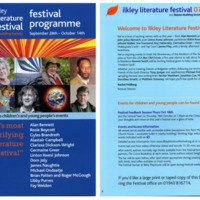
Ilkley Literature Festival, 2007
A number of events to mark the bicentenary of the Abolition Act of 1807 took place as part of Ilkley Literature Festival in 2007. Authors Caryl Phillips and Ben Okri discussed their work, and writers from the Peepal Tree Press Freedom Project premiered their poetry. 2007 Poet in Residence Rommi Smith invited festival goers to help create a unique literary 'Freedom Quilt', and gave a multi-media performance drawing on her recent visit to the Gambia. Street theatre was provided by performances of Sugar Beat Skank by Regeyshun Dance and the Leeds Bi-centenary Transformation Project. Members of the Leeds Diasporian Stories Research Group shared new material uncovered in the course of their research into the links between Yorkshire and the Atlantic trading world, and actor Joe Williams performed and answered questions as the African abolitionist Olaudah Equiano.
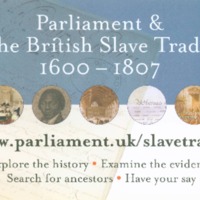
The British Slave Trade: Abolition, Parliament and People
This exhibition in Westminster Hall told the story of the pressures and events, at home and abroad, which influenced Parliament's abolition of the British slave trade in 1807. The Act itself was displayed alongside petitions sent to Parliament by the public. Also on display was Thomas Clarkson's African Box, used on his abolition tours.
As part of the wider project, the Parliamentary Education Service appointed poet and writer Rommi Smith as Parliamentary Writer in Residence to the exhibition. In a series of workshops, Rommi worked with secondary school pupils to explore the historical, social and emotional issues around the transatlantic slave trade in poetry and prose. This included letters and statements that they would have sent to the prime minister of the time, to Olaudah Equiano and other key figures. To mark the UNESCO International Day for the Remembrance of the Slave Trade and its Abolition on 23 August 2007, the Parliamentary Education Unit asked people to submit squares for a commemorative quilt. Some of these designs are available to view on the Parliamentary Archives website, which also uses original source material to tell the story of Parliament's complex relationship with the British slave trade.
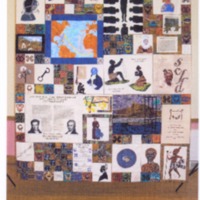
In Stitches
The In Stitches project was led by the African Families Foundation (TAFF) and brought together British, African and African-Caribbean women's quilting groups meeting in London, Liverpool, Bristol, Manchester and Birmingham. The In Stitches Quilt, designed by Janice Gunner, included 60 squares of embroidered images, texts and symbols, depicting historic figures, scenes and artefacts associated with the transatlantic slave trade and its abolition. The Quilt used several of the Adinkra symbols from Africa, originally printed on fabrics worn at funerals by the Akan peoples of Ghana. The accompanying work pack was designed to support learning about slavery based on the four themes of the Quilt: Capture, the Middle Passage, Life in the 'New World', and Proscription of Slavery. The Quilt was unveiled at City Hall in London, and then toured to the British Empire and Commonwealth Museum (Bristol), Central Library (Liverpool), Soho House (Birmingham), the International Quilt Festival (Birmingham) and Central Library (Manchester).
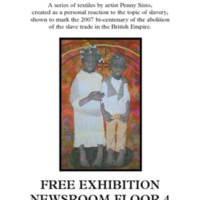
Threads of Strength and Fortitude
Threads of Strength and Fortitude was an exhibition of a series of textiles by artist Penny Sisto, created as a personal response to the bicentenary. The quilts were shipped over from New Albany, Indiana, and exhibited at the Royal Armouries in Leeds. Eight quilts explored the theme of slavery through depictions of servitude, emancipation and the flight to freedom. Pieces on show include 'Slave Ship 1,' which depicts eight enslaved Africans chained by their necks on a slave ship. Another quilt, 'Ran Away', showed a farmer leading Underground Railroad travellers by lantern light. The exhibition was accompanied by an interactive DVD, 'Ordinary People, Extraordinary Courage: Men and Women of the Underground Railroad in the Indiana and Kentucky Borderland'. There was also a series of events, including guest lectures and workshops on the subject of the abolition of slavery aimed at school and community groups. Art-based workshops explored the themes of peaceful resistance.
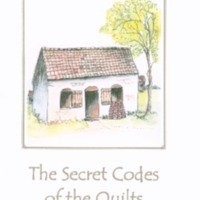
The Secret Codes of the Quilts
The Quaker Quilters of Norwich Quaker Meeting held the Slave Quilts Exhibition at the Friends Meeting House in Norwich in May 2007. By the 1860s in the United States there were organised flights to freedom for enslaved people from the southern plantations via the Underground Railroad – a network of paths leading to the North and Canada. The ‘safe houses’ where assistance was offered on the way were often the homes of Quakers. This exhibition looked to reproduce some of the secret codes said to be hidden within the symbols and patterns featured in quilts made by slaves, to pass on directions to those looking to escape.
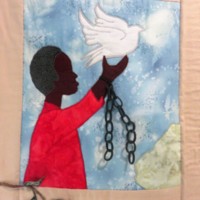
The Abolition of Slavery Quilt
The Abolition of Slavery Quilt was created to commemorate the bicentenary by the Freedom Quilters of Wisbech, a community group with an interest in patchwork and quilting. The quilt is made of several panels, one of which depicts the Thomas Clarkson memorial in Wisbech town centre; other panels stress the link between Christianity and the abolition of the slave trade. It was displayed at Wisbech Baptist Church at the Annual Rose Fair in July 2007. The Rose Fair Flower Festival raises money for charity, and in 2007 had a theme of 'Heroes of Freedom'. The quilt was also loaned to Peckover House, a National Trust property in Wisbech. It remains on display at Wisbech Baptist Church.
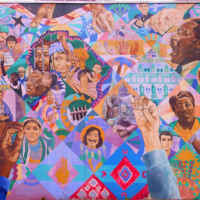
Freedom Quilt Mural
In 1988 David Fichter, with the help of volunteers, painted the Freedom Quilt Mural on the side of the American Friends Service Committee Building in Atlanta, Georgia. The mural was created as part of the Rainbow Coalition events during the 1988 Democratic National Convention. In February 2015 the building, owned by Georgia State University, was torn down – taking the mural with it. The quilted mural is thematically focused on non-violent heroes of history that struggled for justice and peace. It includes the faces of Mubarak Awad, Nelson Mandela, Winnie Mandela, Desmond Tutu, Oscar Romero, Rogoberta Menchu, Leonard Peltier, Andrew Goodman, Fannie Lou Hamer, Daniel Berrigan, Martin Luther King Jr., Rosa Parks, Mahatma Gandhi, and Lucretia Mott. It also includes the antislavery figures of Frederick Douglass and Harriet Tubman. Tubman points towards the North Star. Multi-racial hands stitch the quilt together, joining heroes (both famous and unknown) from all strands of history.
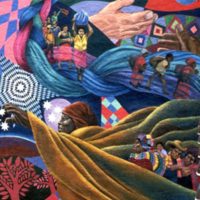
Sanctuary: the Spirit of Harriet Tubman
In 1986, muralist David Fichter created a mural on the side of the Paul Robeson Theatre in Atlanta, Georgia. The mural was sponsored by the city of Atlanta, and depicts Harriet Tubman leading slaves to freedom via the Underground Railroad, against a quilted backdrop..